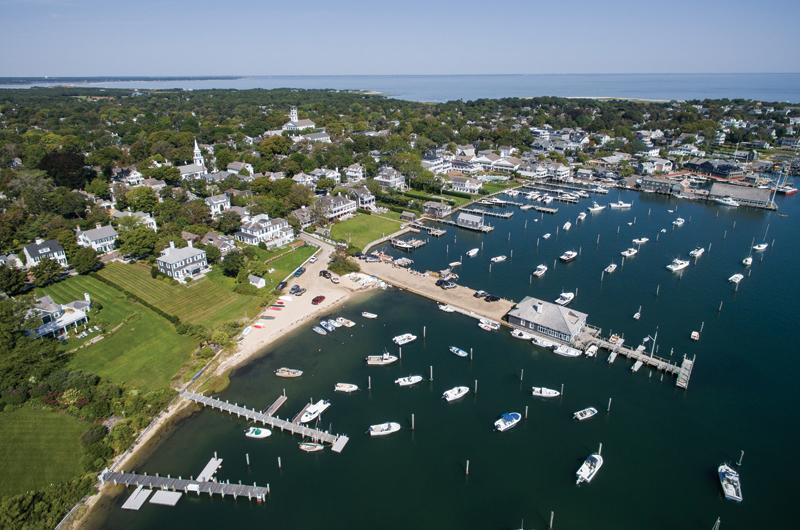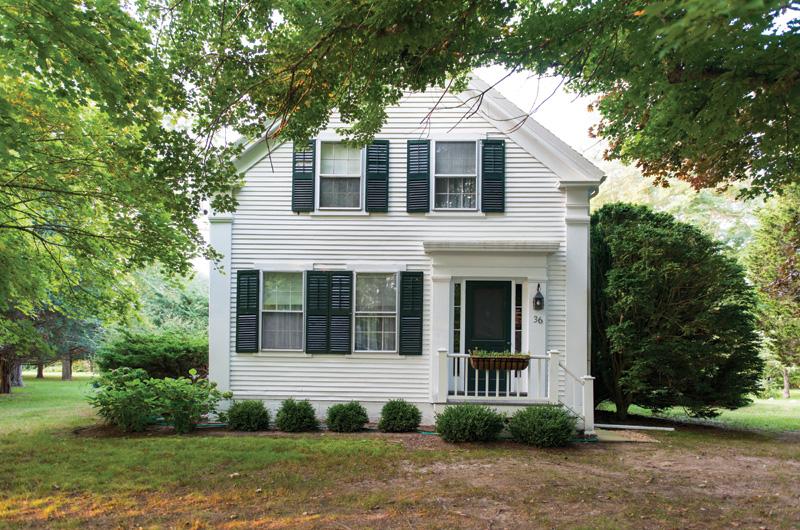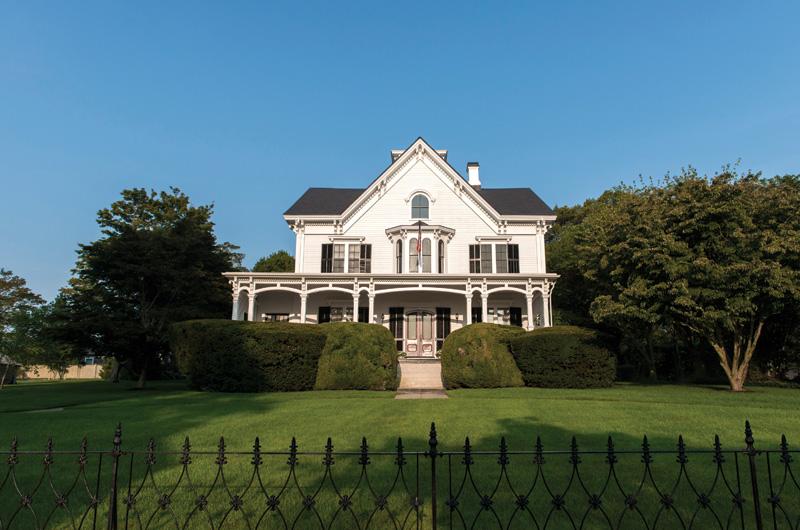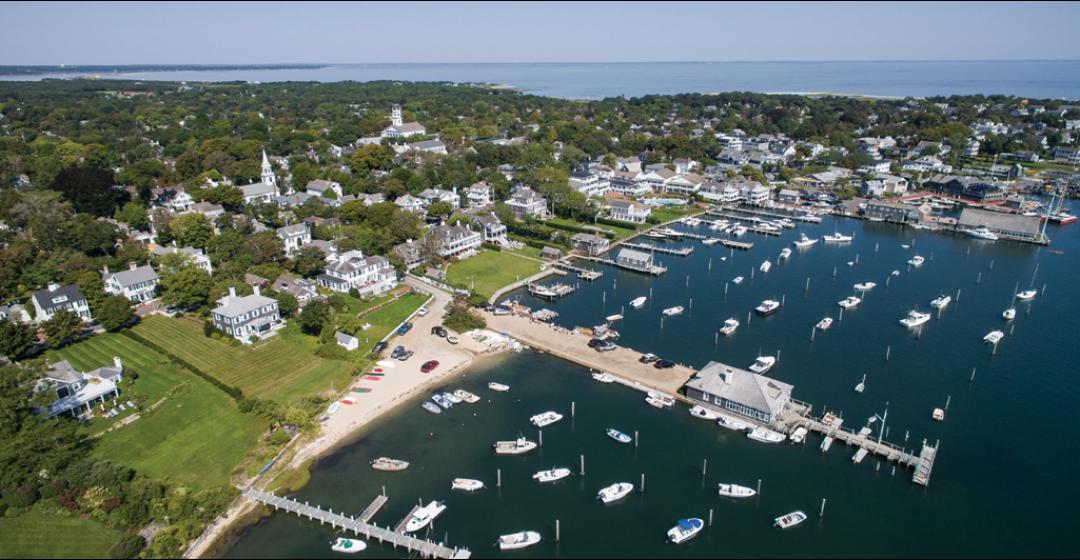All was calm, all was bright on a December evening in downtown Edgartown a few seasons back: snowflakes wafted from the sky and sugarcoated the streets. Lights twinkled along picket fences. Electric candles stood sentry behind multi-paned windows. Storefronts preened in holiday mode. The scene begged for carolers in top hats and bustles under the glowing street lamps, but it made do with a half dozen men and women in fleece and down, making tracks through the powder. They were the commissioners of the Edgartown Historic District on a mission: to peer at the roof of a dormer on a new carriage house off Main Street. A manufacturer’s sample of a shiny black slab lay across the asphalt tiles. Tiny Tim would have been befuddled.
Commissioner Carole Berger sighed. “The state is encouraging the use of solar energy,” she said. “I suppose we need to be flexible.”
“Flexible” may not be the first word that comes to mind to historic district denizens in Edgartown, or anywhere else in the world for that matter. Sooner or later, they’re likely to encounter the policies and processes that inform what they can and can’t do with their private properties. They bought their homes with their hard-earned or not-so-hard-earned money, thank you very much. Or maybe they inherited homesteads built by their ancestors. And now here comes the “hysterical” commission, as some have dubbed it, judging the worthiness of every proposed new shutter or shingle. Aren’t property rights guaranteed by the Constitution? Well, yes – unless they’re not.
Four of the Vineyard’s six incorporated towns – Edgartown, Oak Bluffs, Tisbury, and West Tisbury – have officially recognized historic districts, largely in downtown areas that saw their development heydays in the nineteenth century. The authority of these districts goes deep: all were voted into being by their town electorates, sanctioned by the attorney general of the commonwealth, and date-stamped into perpetuity at the Dukes County Registry of Deeds. Like more than a hundred other local historic districts in the state, they’re endorsed and guided by the Massachusetts Historical Commission, which is inspired in turn by the preservation aims of the National Park Service.
Each historic district on the Vineyard is unique in its backstory and architecture, in its architectural guidelines, and in the ways the commissioners go about their business. What the districts have in common is a rather similar set of bylaws, tweaked from a template of the Massachusetts Historical Commission. To boil down the key provision: the local Historic District Commission has jurisdiction over alterations to exterior building features that are open to view from a public way – the operative language being exterior and public way. The commissioners don’t care about changes the general public can’t see, however remote from historic character they may be. “Which is in some ways a shame,” says Harold Chapdelaine, chairman of the William Street Historic District Commission in Tisbury. He frowns on swimming pools, for example, though the commission allows them when properly shielded.
Presumably, most historic district owners value the look and legacy of their properties and neighborhoods. That’s likely the major reason they choose to invest and live there, along with the conveniences of in-town living. Moreover, in-town properties – historic or not – tend to hold high market values. But that hardly means everyone greets the commissions as liberators. Humans aren’t hardwired to enjoy restrictions and scrutiny, except maybe when they’re applied to others. “I just love undergoing a review by the Historic District Commission” isn’t a popular refrain.

In hindsight, historic districts might seem inevitable on the Vineyard. What could be more Yankee than tradition and preservation? And what could be more Vineyard than standing firm against the encroachment of townscapes typical of Anywhere, U.S.A.? But forty years ago it was by no means a sure bet that the heart of the Island’s towns would be protected. And there’s nothing to guarantee that the future stewards of the Island’s infrastructure will be of a similar mindset. With Edgartown voters slated to consider expanding their historic district, it’s anyone’s guess which way the town meeting vote will go. This despite the fact that the scale of alterations permitted in the town’s current historic district suggests to many that there are no teeth to fear in the restrictions.
In the late 1960s, as land developers surged across the Island, transforming cow pastures into housing developments and clearing forests for golf courses, preservation-minded Vineyarders began to wake up and say, “Whoa.” The foremost conservation concern on-Island – then and now – was for the natural environment. Yet some observers took note of the precarious state of the Island’s infrastructure of antique buildings. Some structures dated back to colonial times. Some represented the best in, say, Federalist or Victorian architecture. Many were withering. Many had been altered beyond historic recognition. Many had been demolished. The alarming realization was that whatever antiques remained intact and largely unadulterated had survived by sheer happenstance.
In 1975, concerned residents created the Martha’s Vineyard Historical Preservation Society (it would later become the Martha’s Vineyard Preservation Trust in 1992), a private, nonprofit entity dedicated to the stewardship of significant Island landmarks such as Edgartown’s Dr. Daniel Fisher House and the Old Whaling Church. But to prevent whole neighborhoods from being transformed, other Islanders began seeking the protection that only a government-sanctioned historic district can provide.
Edgartown Historic District commissioner Edith Blake recalls a small, convivial dinner party around 1972. John Golding, pastor of St. Andrew’s Church, was there, along with the late Vineyard Gazette publisher Henry Beetle Hough, and several others. “After dinner, we were all outside on the sidewalk, chatting and laughing in the moonlight. Someone brought up the idea of creating an historic district in town, and everybody enthusiastically said they wanted to be part of it.” A study committee was born. But soon thereafter, “everyone became ill,” and in short order Blake was an active study committee of one.
The making of a historic district in Massachusetts is not for the halfhearted. Selectmen must be petitioned, state applications must be filed, properties must be inventoried, maps drawn, bylaws drafted, and the public engaged through polls, notifications, and hearings. The savvy study committee also mounts a public relations campaign to extol the benefits of the proposed district – its importance to the historical record, local character, community pride, and, last but not least, the tourism economy – lest the vote to approve go down in flames on the basis of myth and fear.
On the Vineyard the process was complicated by the reality that a large proportion of the property owners in the proposed historic districts were seasonal, non-primary residents. They were included in the various polls and notifications about the districts, but didn’t get to vote.
Blake, the study-committee-of-one, already knew the future Edgartown Historic District intimately. Though she grew up on New York’s Park Avenue, her family summered in downtown Edgartown and moved to the Island year round in 1964, living in various in-town homes. As a child she used to bicycle to Main Street to deliver the family’s garments to Mr. Butler, the dry cleaner in the tiny one-story building that was most recently occupied by Great Harbour Gourmet & Spirits. Some thirty years later, she was back on a bicycle, photographing and taking notes on building after building – “350 Greek Revivals on the north side alone” – for the copious documentation required for the historic district application’s property inventory.

She set up a makeshift office in a boathouse and spent an entire winter developing photos and compiling paperwork. Then the state changed the inventory forms. She did the paperwork all over again. When at last all the papers were in order and the ducks in a row, the historic district measure failed in an Edgartown town meeting by two votes. The measure was voted at a town meeting two more times, in the 1970s, and both times it narrowly failed.
Blake points the finger at an opposition rally led by the late Bob Carroll, an influential local developer and selectman known for his diehard defense of individual rights on many a political front. The Edgartown Historic District wouldn’t come into being for another decade, and then only after it was conspicuously gerrymandered in the eyes of some observers, barely extending down the crossroads of Main Street. Which is why a 1920s bungalow at the altogether historic-looking corner of Morse and North Summer Streets, for example, was demolished with impunity in 2011.
Bragging rights thus went to Tisbury for establishing the first historic district on the Vineyard, in 1975. (West Tisbury followed suit in 1982, and Oak Bluffs, the heart of which was partially protected by an earlier designation by the Martha’s Vineyard Commission, established the Cottage City Historic District in 2003.) According to the letter presented to every new owner within the William Street Historic District, it was created “by a group of town residents who possessed the vision to protect these historic properties, thus perpetuating the historic quality of the port of Vineyard Haven.” The letter begins warmly enough – “Congratulations on your recent purchase” – but hastens to lay down the law: “Building permits will not be issued by the Town of Tisbury without Commission approval.” What follows is a sheaf of paper detailing its guidelines, ranging from shutters to new doors to paint colors.
William Street is the smallest and probably most manageable of the Island’s historic districts, comprising just fifty-five properties in a relatively homogeneous area that escaped Tisbury’s infamous downtown fire of 1883. Today, four of the seven commissioners live in the district year round. One resident commissioner has been known to invite the whole district over for brunch. But it isn’t always lemonade and lobster rolls. One resident commissioner has a neighbor who has barely spoken to her in years, after a commission decision didn’t go the neighbor’s way. Never mind that this commissioner recused herself from the deliberations; the neighbor apparently deemed her guilty by association.
The bright side is that most commission deliberations Islandwide end agreeably – sometimes even with smiles on both sides of the table. For a simple application, such as a roof replacement with like-kind shingles, commissioners typically vote to approve a quick “certificate of non-applicability,” in historic district parlance. A remodeling of a porch, say, will likely require a public hearing.
For a complex project, on the other hand, the hearing may be continued to a subsequent commission meeting a month later. And then some. “An application to put an addition on a house usually takes three to five meetings and hearings to work out,” says Chapdelaine of the William Street district.
“We’re hoping to get this approved in one hearing,” said one really, really optimistic contractor as he presented his client’s application for a new modular home before Oak Bluffs’ Cottage City Historic District Commission last year. The commission ultimately approved a Certificate of Applicability for the project – five meetings and six months later.

It’s the usual devil at work: details. What a property owner may proudly look upon as historic might merely be historic-ish in the eyes of district commissioners. Their brows may wrinkle over a proposed roof pitch, shed dormer, spindle turn, crown molding, sconce light, or simply size. And let’s not forget the neighbors, who at public hearings can and do chime in, pro or con. Arguably, one of the best prerogatives of living in a historic district is the invitation to sound off about the other guy’s dream plans.
Even if everyone agrees on the design side of the conversation, it’s building materials that are often the bigger bone of contention. After all, did the carpenters who crafted the Vineyard’s period Federalist mansions or gingerbread cottages slap on vinyl siding or use weatherproof synthetic trim? No, they did not.
In the spring of 2013, historic district commissioners and administrators from across the Island gathered at the Old Whaling Church for a forum with Chris Skelly, director of Local Government Programs for the Massachusetts Historical Commission. “Let’s ask Skelly” is a refrain oft heard at commission meetings when commissioners feel they need clarity on their authority from the state’s historic district guru. Commissioners aren’t as presumptive about their powers as some skeptics may think.
A couple of local building contractors also attended the Skelly forum, resolute in their reason for being there: Let’s ask Skelly if the state has anything against Azek, which these local commissions keep giving us the blues about. Azek is a leading brand name of a new breed of building materials made of polyvinyl chloride, or PVC – the stuff of common white drain pipes. Introduced to the marketplace about a decade ago, long after the Island’s historic districts first drafted architectural guidelines, PVC trim boards, skirt boards, porch decks, and posts are now the darlings of the construction industry. PVC and other new-age plastics don’t suffer the ravages of time and climate like wood and paint do. Moreover, from a giant step back, many synthetic building applications are arguably hard to tell apart from their painted wood counterparts. One might ask: what makes a historic home look worse? An unblemished PVC trim board or a rotting, alligator-skinned wooden one?
While Skelly stressed that the state commission would rarely, if ever, recommend using new materials on historic buildings, the final say resides with the local commissions. “Architectural guidelines are just that – guidelines,” he said. “They can be applied on a case-by-case basis. It’s okay to make exceptions to the rules. It’s okay to change the rules over time.”
Commissioners, who after all probably have trim of their own, do have hearts. Cottage City recently began approving Azek skirt boards. “Wooden skirts, close to the ground, are especially hard for people to maintain in this climate,” says Cottage City Historic District commissioner David Wilson. Both Edgartown and William Street have blessed applications for shutters made of ABS, or acrylonitrile butadiene styrene – the material of automobile bumpers. But those shutters had better be made to look operable, with appropriate hardware, and they’d better be painted historically appropriate black or deep green.
Do exceptions to the rules ever raise the public eyebrow? Is there ever a suspicion of preferential treatment? “With almost every application,” says Chapdelaine, with a laugh. “Over time, I think we’re going to find more pressure and more reasons to use alternative materials,” he adds, emphasizing that he’s speaking for himself, not his commission. “I suspect that manmade construction materials have a smaller carbon footprint than the repetitive replacement of wood and paint.”

So: your current desires include a visible skylight on your Queen Anne Victorian on Oak Bluffs’ Ocean Park? Don’t push it. A stockade privacy fence in lieu of capped pickets along Edgartown’s South Summer Street? Ain’t happening. Sliding glass doors on William Street? Oh, heavens. Solar panels atop the mansard roof of West Tisbury’s town hall, right in the middle of the historic district created by the town in 1982?
Well, okay! Solar energy has been something of a game changer for historic districts, with the gentle prod of the Massachusetts Historic District Act, which points out the state’s interest in promoting solar energy. Solar panels were unanimously approved for an Edgartown garage in view of Main Street and the Dr. Daniel Fisher House. They were approved for a home on William Street, and for West Tisbury’s town hall. “If solar panels had existed a hundred years ago, people would have used them,” says Lanny McDowell, a West Tisbury commissioner who voted in favor of the town hall installation. “In a way, it fits with the tradition of a New England village – to approve something that saves money and makes practical sense.”
Window replacements are another matter, whether your aim is energy efficiency or just having sashes that open and shut properly for a change. After all, windows are among a building’s most prominent exterior features. Custom manufacturing is nearly always required to fit new windows to the dimensions of period openings, and resizing the openings to today’s conventions is frowned upon. Budget-friendly vinyl frames are taboo, and in Edgartown, divided-light windows must be truly divided, with each pane framed within its mullions – yes, wood mullions. Cottage City will settle for faux-divided lights, but those mullions must be raised and realistically affixed to the exterior of the panes. The William Street commission won’t allow vintage windows to be removed in the first place, unless deemed fully deteriorated by a qualified engineer. Such was the hurdle the Martha’s Vineyard Playhouse successfully jumped to replace its majestic 12-over-12s during its recent building restoration.
The short of it is, replacing windows to historic district satisfaction hardly comes cheap. Yet modern storm windows get a pass in every district as temporary non-fixtures. “You kind of have to be in favor of solar energy, and you kind of have to be in favor of windows people can live with,” says West Tisbury commissioner Nancy Dole with a tone of resignation. “It’s an art form,” says Chapdelaine of Tisbury. “You can modernize a historic property, letting the interior live by current desires while still presenting ‘historic’ from the curb.”
Not surprisingly, not everyone is a believer. This is the Vineyard, after all. “If I don’t comply with your determination, what are you going to do about it?” asked an applicant with a touch of swagger at a Cottage City Historic District meeting. With utmost cordiality, longtime commissioner Wilson read the applicant the riot act – er, the bylaw – which empowers the commission to petition the superior court to order the remediation of a violation with monetary fines. Applicants may also appeal to the superior court if they feel they’ve been aggrieved by an act of the commission, but in practice, with the exception of a recent Azek-related case in Edgartown, historic district disputes manage to reach resolution out of court.
It pains commissioner Carol Berger of Edgartown to occasionally come across a real estate ad that boasts that a property is not in a historic district. “We need to do a better job of communicating to the public that owning and living in a historic district is something special,” she says.
“To be a steward of one of these historic properties for a period of time is an honor,” echoes Cottage City commissioner Phil Regan, an architect and Oak Bluffs native who grew up admiring the infrastructure that surrounded him. “It’s something to be proud of.”
“Why do people walk through the historic districts?” asks Chapdelaine. “Or through the old cities and towns of Europe? Because they return home enamored of where they’ve been. It’s up to us to recognize that and take responsibility for these properties – and then hand them off in a healthy way.”





